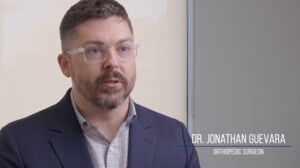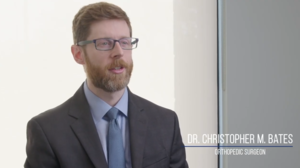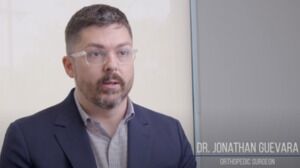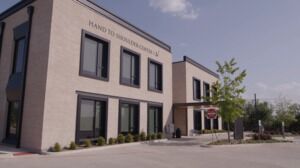Description
Dr. Christopher Bates explains that hand surgery performed in his office doesn't require general anesthesia. It may be recommended for a number of reasons, including obstructed movement and bumps that develop on the wrist or fingers. Dr. Bates says after in-office surgery, patients can drive themselves home and remove bandages after a couple of days.
View transcript
[00:00:07.160]
So in-office surgery is just regular surgery.
[00:00:10.360]
We just do it here in the office.
[00:00:12.320]
Rather than putting you to sleep and putting your brain to sleep,
[00:00:15.760]
we just put your hand to sleep.
[00:00:17.560]
It allows us to do the exact same thing
[00:00:19.840]
we would do in the surgery center or in the hospital,
[00:00:24.040]
but we get to do it here in the office.
[00:00:26.040]
So patients come to me asking about in-office surgery
[00:00:28.960]
for several different reasons.
[00:00:30.760]
Usually it's numbness in their fingers or numbness and pain in their hand.
[00:00:35.200]
Sometimes a finger that's catching or locking or triggering,
[00:00:38.880]
and sometimes it's a bump on the back of the wrist
[00:00:41.440]
or the front side of the wrist,
[00:00:42.920]
or even a bump on the tip of the finger.
[00:00:45.160]
And those patients asking about in-office surgery
[00:00:47.960]
are pleasantly surprised when we tell them,
[00:00:49.760]
"Yes, we can do those surgeries here."
[00:00:52.440]
So when a patient comes in to be evaluated,
[00:00:55.360]
they come in, we have X-rays here, if we need to get those.
[00:00:59.080]
We gather all their medical records ahead of time
[00:01:01.600]
to make it as easy as possible and as simple as possible for them.
[00:01:05.720]
They have time with me where we look at their imaging,
[00:01:08.960]
we look at any test results they've had.
[00:01:11.280]
And I examine the patient in a very detailed way
[00:01:14.120]
to help make sure that we make the right diagnosis,
[00:01:18.040]
and then we come up with a personalized treatment plan for them.
[00:01:21.160]
So when a patient qualifies for surgery in the office,
[00:01:24.880]
we set them up with a particular date that works with their schedule.
[00:01:29.080]
They come in, they can drive themselves to the office.
[00:01:33.280]
They come into the office, we get them numbed up for the procedure.
[00:01:37.240]
Then we perform the procedure in our sterile procedure room.
[00:01:41.320]
Once that patient is done, we make sure that they feel all right
[00:01:45.520]
and they get up and they drive themselves home.
[00:01:48.040]
So after in-office surgery,
[00:01:50.080]
the patient can usually take off the dressing or bandage
[00:01:53.560]
in about two to three days.
[00:01:55.640]
After that, they can start taking a regular shower
[00:01:58.800]
and get back to daily activities as tolerated.
[00:02:02.320]
Now, depending on the surgery, they'll have more or less discomfort,
[00:02:05.760]
but it's exactly the same amount of pain
[00:02:08.080]
that you would experience after having that surgery and being asleep.
[00:02:11.880]
So the best way for patients to find out if they're candidates for treatment
[00:02:15.760]
is to come in and get evaluated.
[00:02:18.120]
There are lots of different questionnaires online that can help a patient identify
[00:02:23.400]
if they have a certain diagnosis or a certain problem,
[00:02:27.080]
but really, that one on one discussion and examination with the surgeon
[00:02:31.720]
is the absolute best way to find out what they have exactly
[00:02:36.680]
and if they would benefit from surgery.





















